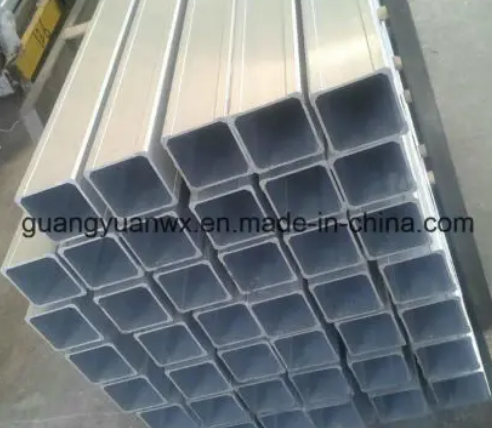Aluminum pipes are a critical component in various industries due to their lightweight, corrosion resistance, and high thermal conductivity. Understanding the sizes and types of aluminum pipes available is essential for selecting the right product for specific applications. This article delves into the various sizes of aluminum pipes, their applications, and the factors influencing their selection. For those interested in the specific characteristics of Aluminum Seamless Pipe, this guide will provide valuable insights.
Understanding Aluminum Pipe Sizes
Aluminum pipes come in a variety of sizes, typically measured by their outer diameter (OD) and wall thickness. The size of an aluminum pipe is crucial as it determines the pipe's capacity and suitability for different applications. Standard sizes range from small-diameter pipes used in precision applications to large-diameter pipes for structural purposes.
Standard Aluminum Pipe Sizes
Standard aluminum pipe sizes are determined by industry norms and vary depending on the application. For instance, the American National Standards Institute (ANSI) and the American Society for Testing and Materials (ASTM) provide guidelines for pipe dimensions. Common sizes include diameters ranging from 0.5 inches to over 10 inches, with wall thicknesses varying accordingly.
Custom Aluminum Pipe Sizes
In addition to standard sizes, aluminum pipes can be custom-made to meet specific requirements. Customization involves altering the diameter, wall thickness, and length to suit particular applications. This flexibility is particularly beneficial in industries where unique specifications are necessary, such as aerospace and automotive manufacturing.
![Is Aluminum Tubing Measured ID Or OD Is Aluminum Tubing Measured ID Or OD]()
Factors Influencing Aluminum Pipe Selection
Selecting the right aluminum pipe involves considering several factors, including the intended application, environmental conditions, and budget constraints. Each factor plays a significant role in determining the most suitable pipe size and type.
Application Requirements
The intended use of the aluminum pipe is the primary consideration in selection. For instance, pipes used in fluid transport must withstand internal pressure, while those in structural applications need to support loads. Understanding these requirements helps in choosing the appropriate size and type of pipe.
Environmental Conditions
Environmental factors such as temperature, humidity, and exposure to chemicals can affect the performance of aluminum pipes. Pipes exposed to harsh conditions may require thicker walls or special coatings to enhance durability and resistance to corrosion.
Budget Considerations
Cost is always a factor in material selection. While aluminum pipes are generally cost-effective, custom sizes or special treatments can increase expenses. Balancing performance requirements with budget constraints is essential for optimal selection.
Applications of Aluminum Pipes
Aluminum pipes are used across various industries due to their versatility and beneficial properties. From construction to transportation, these pipes play a crucial role in numerous applications.
Construction Industry
In construction, aluminum pipes are used for scaffolding, structural supports, and piping systems. Their lightweight nature makes them easy to handle and install, while their strength ensures structural integrity.
Transportation Sector
The transportation industry benefits from aluminum pipes in the manufacturing of vehicles and aircraft. Their light weight contributes to fuel efficiency, while their durability ensures longevity and safety.
Industrial Applications
In industrial settings, aluminum pipes are used in machinery, equipment, and process systems. Their resistance to corrosion and high thermal conductivity make them ideal for heat exchangers and fluid transport systems.
Conclusion
Understanding the various sizes and applications of aluminum pipes is crucial for selecting the right product for specific needs. Whether for construction, transportation, or industrial use, the right aluminum pipe can enhance performance and efficiency. For those seeking more detailed information on Aluminum Seamless Pipe, further research and consultation with experts are recommended.
FAQs
Q1: What are the standard sizes of aluminum pipes?
A1: Standard sizes range from 0.5 inches to over 10 inches in diameter, with varying wall thicknesses depending on the application.
Q2: Can aluminum pipes be customized?
A2: Yes, aluminum pipes can be custom-made to meet specific requirements, including diameter, wall thickness, and length.
Q3: What factors should be considered when selecting aluminum pipes?
A3: Consider the application requirements, environmental conditions, and budget constraints when selecting aluminum pipes.
Q4: What are the common applications of aluminum pipes?
A4: Aluminum pipes are commonly used in construction, transportation, and industrial applications due to their versatility and beneficial properties.
Q5: How do environmental conditions affect aluminum pipes?
A5: Environmental factors like temperature and exposure to chemicals can affect performance, necessitating thicker walls or special coatings for durability.
Q6: Why are aluminum pipes preferred in the transportation sector?
A6: Their lightweight nature contributes to fuel efficiency, and their durability ensures longevity and safety in vehicles and aircraft.

















